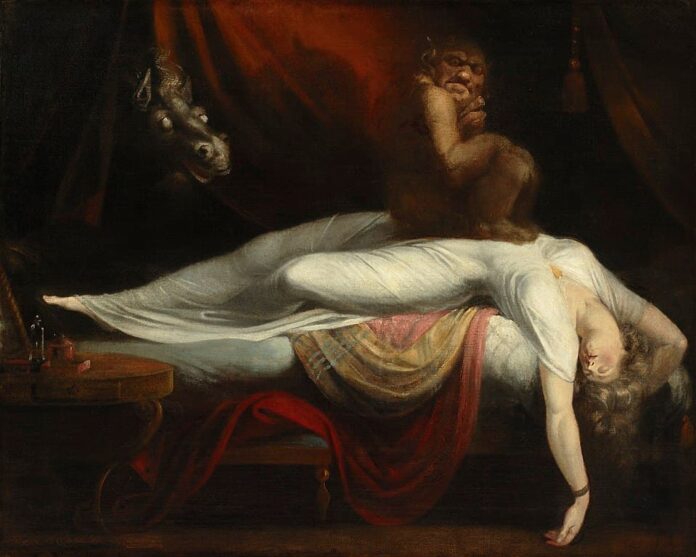Sleep paralysis is a very scary experience that many people have gone through at least once in their lifetime. It can happen to anyone, and it occurs to people of all ages. People often have stories to tell after they went through one, and some are rather creepy. It could be because of the hallucinations, and it could be real because there is no treatment for sleep paralysis. There is even a term for fear of sleep paralysis which is “Somniphobia”. You probably found this article because you had just experienced one, and there are some interesting facts about it below.
1What Is Sleep Paralysis?
Sleep paralysis is a feeling of being conscious but unable to move, mostly occurring when a person is sleeping. Scientifically, it happens when a person passes between stages of sleep and wakefulness. During these transitions, the person may be unable to move or speak for a few seconds up to a few minutes. In some cases, it can last up to 10 minutes or even longer. Some people also experience pressure or a sense of choking while being unable to move. When individuals remain aware during the episodes, it often involves troubling hallucinations and a sense of suffocation.
This condition is categorized as a type of parasomnia which is abnormal behaviors during sleep. If sleep paralysis occurs while you are falling asleep, it is called hypnagogic or predormital sleep paralysis. During this moment, your body slowly relaxes as you fall asleep. Usually, you become less aware when sleeping so you do not notice the change or the inability to move. In case you become or remain aware while falling asleep, you may notice that you cannot move or sleep. Then, it is called hypnopompic or postnominal sleep paralysis if it happens as you are waking up.
2Is Sleep Paralysis Serious?
Sleep researchers conclude that sleep paralysis is a sign that your body is not moving smoothly through the stages of sleep. Also, it is rare that sleep paralysis links to deep underlying psychiatric problems. However, sleep paralysis may accompany other sleep disorders such as narcolepsy. Narcolepsy is an overpowering need to sleep caused by a problem with the brain’s ability to regulate sleep. You should check with your doctor if you have concerns like:
- You feel anxious about your symptoms
- The symptoms keep you up during the night
- Your symptoms leave you very tired during the day
3What Causes Sleep Paralysis?
Sleep paralysis is a very common condition that 4 out of 10 people may have, especially teens. Men and women of any age can have sleep paralysis, and it may even run in families. Some factors that may cause sleep paralysis are:
- Substance abuse
- Sleeping on the back
- Sleep schedule changes
- Jet lag or panic disorder
- Insomnia or lack of sleep
- Nighttime leg cramps or narcolepsy
- Certain medications such as those for ADHD
- Mental conditions such as bipolar disorder or stress
4How To Prevent Or Get Rid Of It?
The thing is that there is no treatment for sleep paralysis. However, there are certain things that you can do to prevent sleep paralysis. Those include:
- Try new sleeping positions if you sleep on your back
- Outfit the bed with a comfortable mattress and pillow
- Treat any sleep disorders such as leg cramps or narcolepsy
- Put away smart devices like phones at least a half hour before bed
- Make the bedroom convenient and free from intruding light or noise
- Reduce consumption of alcohol and caffeine, especially in the evening
- Treat any mental health problems that may contribute to sleep paralysis
- Use antidepressant medication if it is prescribed to help regulate sleep cycles
- Improving sleep habits by making sure that you get 6 to 8 hours of sleep each night
5How To Wake Up
Because it is a very terrifying experience, almost everyone tries to move although it is to no avail. When it occurs, there are a few things that you can do to wake up.
- Stay Calm: Think of it as a condition that you can get out of, and try to stay calm.
- Don’t Fight: When you struggle to get up, it will only increase the trapped feeling which leads to more fear and panic. The more you try to move, the more difficult and frightening you will get. So relax, and breathe in and out slowly.
- Close Your Eyes: Most people experience scary hallucinations with things they are afraid of while opening their eyes. During the episodes, you should always close your eyes instead of trying to move and look around. Remember that hallucinations scare people because everything always looks so real which increases the level of terror.
- Clench & Wiggle: Instead of opening your eyes and looking around, try to move the muscles. Move your fingers and toes as much as you can, and doing so will help you to break out of the episode. Always tell yourself that it is a normal thing and it cannot hurt you. Focus on breathing while closing your eyes and moving your fingers and toes. You will either fall back asleep if you are calm enough or be able to move and get up.
Related Post: Short Scary Stories Told By Kids




